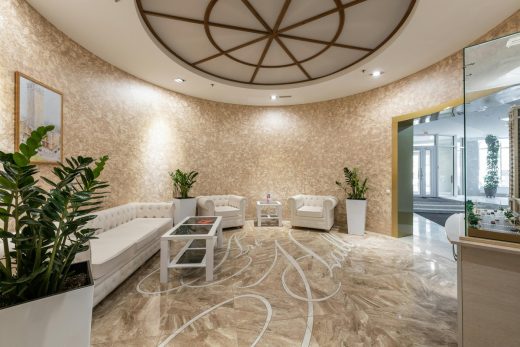10 hotel interior design tips, Checking in services, Accommodation branding
10 Hotel Interior Design Tips You Must Know
1 October 2024
10 Tips You Must Know About Hotel Interior Design — Full Guide
Interior design in hotels does not only involve choosing between this furniture and that color of paint but it involves providing guests with the experience when they are checking in up to the time they leave. This piece is therefore a friendly guide for hotel owners as well as interior designers that reveal vital factors that determine the success or failure of guests’ experience. As a reference for your success, below is the ultimate guide, which not only highlights design as a parameter but also the usability, comfort, and satisfaction of your guests.
- 1. Finding Out More about Your Hotel’s Branding
Therefore, the first and one of the most vital aspects of hotel interior designing is branding of the hotels. It’s important for incorporating the best hotel design by first having a clear understanding of the brand behind the hotel. The interior design should in some way reflect the overall idea, the intended clientele as well as the concept of the hotel.
For example, a boutique style hotel focused to cater to the affluent market must give off a sense of sophistication and selectiveness. This can be achieved through high-quality material such as marble, velvet made and gold accent. Conversely, a low-cost hotel appealing to business people for example will prefer sleek and plain designs for a simple look, dull colors and ergonomic and affordable hotel equipment that adds to the comfort and aesthetic appeal.
Key Points:
Determine which features make your brand stand out.
Then you should strive to make the design match with what your target group likes.
Make certain that even such basic elements as furniture in the bedrooms of the hotels and lighting correspond to the brand narrative.
- 2. The theme here is specifically guest comfort or better still guest satisfaction.
In as much as form follows function, it is important now to note that the comfort of the guests is the goal of any hotel and this includes the design aspect. Besides that we have the functionality and comfort of your space which attracts the guests and makes them make a booking a place. This relates from the type of fabrics used from the bedding to type of furniture used in a hotel right from the manner in which rooms have been arranged.
Due to the intended concept, considerations should be made to factors such as premium quality mattresses, lamping, blackout curtains and noise reducing features for a good night’s sleep. The furniture in hotel rooms should be chosen with end-use in mind: if it’s leisure, then some furniture like chairs required to read a book, lounge or work in a hotel room should be provided, and if it is business, then provision of desk to do business and storages that can easily be reached out and cleaned societies should also be provided.
Key Points:
Pay a great deal of attention to the sheering and mattress.
Adopt ergonomic hotel furniture for leisure and that which can facilitate working while in the hotel.
Install noise reducing products to increase privacy and sleep quality.
3. Impression Management for the First Time Lobby Encounters
Hotel lobby is the first area your clients meet after entering your hotel and the initial impression is very crucial. Lobby design, therefore, should capture the spirit of the hotel and at the same time give the visitor a warm feeling. This area usually acts as a living room for the guests whereby they can be interacting with friends and families or working; therefore, it has to be more than just artistic.
Soft furnishing for the hotel inclusive of comfortable seats, appropriately designed coffee tables, and just the right side tables add to the comfort of the place. Lighting and artwork are important as these are creates the atmosphere of the room or space. A reception desk, well illuminated signs, and basic layouts that are easy to follow cater for the functional aspects. Think of some flashy features which may include a feature wall, a chandelier or some large indoor plants in order to add the extra pang.
Key Points:
Make a statement with a grand focal point.
Ensure that lobby hotel furniture is comfortable and aligns with the design aesthetic.
Combine functionality and aesthetics for a comfortable and welcoming space.
4. Balancing Aesthetics and Functionality in Guest Rooms
Guest rooms are the core of your hotel, and they should balance aesthetics with functionality. These spaces must be designed to provide comfort and convenience, while also delivering a memorable and aesthetically pleasing experience.
To achieve this, opt for a clean and intuitive room layout. Avoid clutter by incorporating smart storage solutions, such as under-bed storage, built-in wardrobes, or multifunctional hotel room furniture products. Desks, chairs, and bedside tables should be chosen not only for their appearance but also for their practicality and comfort. Guests appreciate having a convenient spot for work or relaxation, so selecting hotel furniture that accommodates these needs is essential.
Regarding aesthetics, it’s essential to align with your brand’s style while maintaining a cozy and inviting atmosphere. Use a neutral palette for flexibility, and add pops of color through accessories like pillows, artwork, or rugs.
Key Points:
Ensure rooms are clutter-free and offer practical storage through well-designed hotel room furniture.
Provide modern amenities, such as easy-access charging stations integrated into hotel furniture.
Balance neutral tones with accents of color to create a calming atmosphere.
5. Designing Bathrooms with Comfort and Luxury in Mind
The bathroom is often a deciding factor in a guest’s overall perception of your hotel. Therefore, luxury, comfort, and cleanliness are crucial in bathroom design. Use high-quality materials like marble, porcelain, or brushed metal to create an opulent feel.
Design features such as rainfall showers, deep soaking tubs, and heated floors can enhance the guest experience. Additionally, storage furniture in the bathroom, such as sleek vanity units or shelving, should be practical yet stylish, providing ample space for toiletries without cluttering the room.
The layout of the bathroom should maximize space while ensuring privacy and comfort. Features like separate toilet areas, his-and-hers sinks, and well-designed hotel furniture for storage and functionality add both luxury and practicality.
Key Points:
Use high-end materials to elevate the bathroom’s appearance.
Offer luxury amenities like rainfall showers and heated floors.
Ensure the bathroom layout is spacious, and consider practical storage furniture.
6. Incorporating Local Culture and Art into the Design
One of the best ways to create a unique and memorable hotel experience is by incorporating local culture and art into the design. This not only adds character to the space but also allows guests to connect with the destination on a deeper level.
Feature local artwork, crafts, or hotel furniture that reflects the region’s craftsmanship and materials. Locally inspired design elements can turn your hotel into a cultural haven, enhancing the guest experience. For example, using locally sourced wood for hotel room furniture or featuring textiles crafted by local artisans adds authenticity and charm.
Key Points:
Incorporate local artwork and crafts to offer a unique cultural experience.
Use regionally sourced hotel furniture and materials to enhance authenticity.
Integrate design elements that reflect the local history and culture.
- 7. Optimizing Public Spaces for Socialization and Relaxation
Public spaces in hotels, such as lounges, dining areas, and outdoor patios, serve as communal areas where guests can socialize or relax. The design of these spaces should encourage interaction while offering enough privacy for relaxation.
Consider a mix of seating arrangements to accommodate different guest needs—whether they’re looking to work, relax, or socialize. Comfortable hotel furniture like sectionals, armchairs, and bistro tables ensure guests have a variety of seating options. Additionally, incorporating nooks and private seating areas helps create a more intimate and personalized guest experience.
The design should facilitate easy flow and movement throughout the space. Consider the placement of hotel furniture like sofas, coffee tables, and communal dining tables to ensure an intuitive layout.
Key Points:
Create a balance between social spaces and private areas with well-arranged hotel furniture.
Use a variety of seating options to cater to different guest needs.
Ensure that public spaces are easy to navigate with properly placed hotel furniture.
- 8. Maximizing Sustainability in Hotel Design
Sustainability has become a vital consideration in modern hotel design. Guests are increasingly conscious of eco-friendly practices, and hotels that embrace sustainability not only reduce their environmental footprint but also appeal to a broader audience.
Opt for sustainable hotel furniture made from recycled or eco-friendly materials. Implement energy-efficient lighting and heating systems, such as LED bulbs and smart thermostats. Water-saving fixtures in bathrooms and kitchens can further enhance sustainability, while reclaimed wood or repurposed materials used in hotel room furniture offer a unique yet eco-conscious design element.
Green roofs, solar panels, and smart building management systems are advanced options that can further reduce your hotel’s environmental impact. Additionally, communicate your sustainability efforts to guests, as many travelers prefer to stay in eco-conscious hotels.
Key Points:
Implement energy-efficient technologies and water-saving fixtures.
Use eco-friendly or recycled hotel furniture and materials.
Consider installing green roofs or solar panels for long-term sustainability.
- 9. Lighting Design: Creating Ambiance and Functionality
Lighting plays a critical role in both the functionality and atmosphere of a hotel. Well-thought-out lighting can enhance guest comfort, improve the aesthetics of the space, and influence the mood of each area.
In guest rooms, adjustable lighting options such as dimmers allow guests to control the ambiance. Public spaces like lobbies and lounges can benefit from statement lighting fixtures, like chandeliers, to create a luxurious feel. Task lighting near hotel room furniture such as desks and beds should be bright and focused for functional purposes.
Natural lighting should also be incorporated wherever possible. Large windows, skylights, and glass doors can bring in daylight, creating a more inviting and eco-friendly space.
Key Points:
Use adjustable lighting to create mood flexibility in guest rooms.
Install statement lighting pieces in public spaces to enhance aesthetics.
Maximize natural lighting and complement it with task lighting near hotel furniture.
- 10. Selecting Durable and High-Quality Materials
Hotels endure a lot of wear and tear due to high guest turnover, so it’s crucial to select durable and high-quality materials for everything from flooring to hotel furniture. This ensures that your hotel maintains its aesthetic appeal and functionality for longer periods, even with heavy use.
Choose fabrics and hotel furniture materials that are easy to clean and maintain without sacrificing style. For example, leather or treated fabrics for seating can be both luxurious and long-lasting. Similarly, opt for durable flooring materials like ceramic tile, hardwood, or high-quality vinyl.
High-quality hotel room furniture and fixtures may be more expensive upfront but will save money on maintenance and replacements in the long term.
Key Points:
Invest in durable, easy-to-maintain hotel furniture.
Opt for high-quality flooring options that can withstand heavy use.
Ensure that all hotel room furniture and decor are both stylish and long-lasting.
Comments on this 10 hotel interior design tips article are welcome.
Luxury Hotel Architectural Design
Luxury Hotel Architectural Designs
NoMad London, 4 Bow Street, Covent Garden, central London, England, UK
Design: Roman and Williams
NoMad London Hotel, Covent Garden
Metric Hotel, Westlake community, Los Angeles, Southern California, USA
Design: Aaron Neubert Architects
Metric Hotel
Property
Contemporary Property Articles – architectural selection below:
Comments / photos for the 10 Tips You Must Know About Hotel Interior Design — Full Guide page welcome







